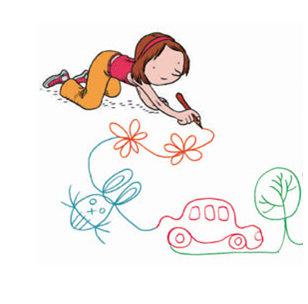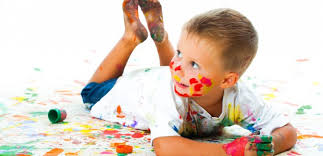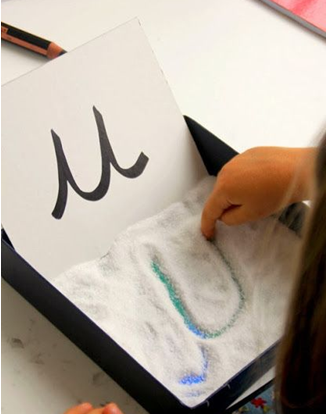
«Behind the hand that draws, there is the entire gesture of the arm and even the gesture of the body that it expresses;
There is all the emotion and all the affective content of that global gesture.
A. Lapierre, B. Aucouturier, Symbolism of movement.
HOW CAN WE SUPPORT OUR CHILDREN?
Writing is the way of communication the most complex ability that man possesses. Learning to write is not a simple task, since it requires a certain degree of intellectual, motor and emotional development. In turn, to achieve the objective of transmitting thoughts, ideas and feelings, the child must acquire certain skills, such as calligraphy (in terms of aesthetics and legibility) and speed. Despite technological advances and the fact that today writing is largely done on computers or other devices (on which we can rely), learning to write is still necessary and essential.
To master these skills, children go through a broad evolutionary process that occurs gradually, beginning with the sketching of the first drawings (scribbles) and progressing to the writing used by adults.
The main factors that promote learning to write are:
The development of psychomotor skills: It is the foundation of the development of writing and its mastery is structurally linked to exercise; it is necessary to learn to organize certain movements in order to reproduce a model. It is a perceptual-motor development, where there is a close relationship between a visual activity of identifying the graphic model (perceptual aspects) and a motor activity of carrying it out. The development of writing is the product of an extremely complex psychomotor activity, in which different aspects participate:
The symbolic function: Writing is a graphic expression loaded with meaning, so the symbolic function is essential for the development of oral and written language. Writing involves understanding, on the one hand, the symbolism of the drawn graphic sign, and also that this sign transmits a message. In order to understand it, the child must have reached a certain level of development of this function.
The language: As Jean Piaget states, from a cognitive point of view, language development is a reflection of the successive stages that a child goes through. Writing is one of the highest forms of language and therefore the last to be learned. This is why, if there are simple delays in language development, we must be aware of how these can affect the development of writing.

Socio-affective development: All development is imbued with affectivity. Writing is a communicative process that requires conscious learning at an early stage, for which the child must have a certain emotional maturity. Learning depends largely on the motivation, affective adaptation and characteristics of the child. Once automation is achieved, the emotional component is reflected mainly in the quality of control of the graphic movement that gives the character of regularity or stability to writing.
Now, What should be the role of adults in this process? First of all, we must take into account that each child is unique and therefore will develop the necessary skills for writing at his or her own pace. We consider it essential that we respect their time and make the learning process a pleasant experience. On the other hand, we must also take into account that mastering these psychomotor skills is not an activity independent of the child's overall development, and that therefore we must encourage this process to accompany emotional, cognitive and social development.
Likewise, adults can help children establish a good bond with graphic expression, generating a climate of affection towards learning that promotes the emotional maturity they need to avoid getting frustrated with the efforts made and to be encouraged (motivated) to continue trying.
Specifically, We can encourage this process by working at home through everyday activities.In these, one must first seek, and before moving on to the actual writing activities, to promote and strengthen certain skills that will later impact the acquisition of reading and writing.
Below we describe some ideas for games that are part of children's daily activities, from which they enjoy and learn a lot.
- Putting together puzzles. This activity involves the child breaking down and reassembling a whole and its parts. It promotes work by coordinating the handling of both hands, putting into practice hand-eye coordination, that is, the coordination of what the child sees with what he has to do with his hands.
- Building or inserting games. In addition to the above, these games also put into practice the different uses and handling that can be given to the same material with its different shapes and sizes. It also helps to develop mathematical and spatial notions.
-
Cut. Another dynamic that we can incorporate is to give magazines or brochures to children with themes that attract them (characters, games, movies, etc.), so that they can cut them out. With this, we encourage the use of a more complex instrument such as scissors, manual skills (use of both hands) are put into play along with visual skills. This activity strengthens concentration and attention, while promoting creativity.
-
Playing with plasticine. In this activity, the child manipulates the material to model it with his hands and fingers, regulating muscle tone (to tighten or loosen the dough as needed). Once again, hand-eye coordination and creativity come into play, allowing him to invent different models.
-
Cards. Card games can also help to support the learning process. It is important to allow the child to shuffle and deal cards, which contributes to the mastery of manual skills. We can also work on joint attention, helping the child to pay attention to the activity along with the other participants, and insist on compliance with the rules and each player's turn.
-
 Draw. By drawing freely, children will be practicing the ability to organize their thoughts. Contact with the pencil and the intensity of the strokes will help them master this skill.
Draw. By drawing freely, children will be practicing the ability to organize their thoughts. Contact with the pencil and the intensity of the strokes will help them master this skill. -
Draw letters on different planes. You can draw some letters (for example, the letters of your name) with tape on the floor or wall. In this way, we encourage the visual perception of shapes and symbols and stimulate creative play: you can make paths with the letters, and if they are on the floor, fill them in with stones, chickpeas, etc.
-
Reading books. Reading stories with our children is an activity that fosters the emotional bond with words. Children often like to be the ones who turn the pages of the book and tell us the story.
-
Use of tablets. Electronic devices are part of our daily lives, so using them consciously and responsibly can help us to promote our children's learning process. For this reason, it is essential to keep in mind that we should never offer this type of stimulation to a child before the age of two. When they are older, it should be for short periods of time and with directed activities. You can download puzzle apps, memory games, letter drawings, mazes, math games, problem-solving games. It is important to be able to share and transmit to children the responsible use and handling of technology. Learning together and knowing that using them in the right measure can provide very valuable tools for learning.
-
Other activities: fasten and unfasten buttons. Tie and untie bows. Screw and unscrew caps. Manipulate small objects (lentils, buttons, etc.). Tear and cut with fingers.
Finally, adults must keep in mind that when developing these activities, and in any instance of playing with our children, it is important to prepare a relaxed and calm environment. This includes reducing the amount of stimuli parallel to the activity itself, for example, turning off the televisions that could be found in the place where the activity is going to take place. Along with this, we must try to encourage an attentive and calm attitude on the part of the child, trying to help him concentrate on the task. Other elements to consider are that the body posture is adequate, and that the grip of the instruments (pencil, scissors, markers, etc.) is correct.
In conclusion, the process of learning to write is key to the overall development of the child, and adults must accompany them as they go through it, being attentive to the needs that each child may present. This is why we believe it is essential that our students have the support and containment of both the school and their families. We invite and encourage you to find moments with your children where you can develop some of the proposed activities, thus promoting joint work for learning to write.
Psm. Federica Bonino